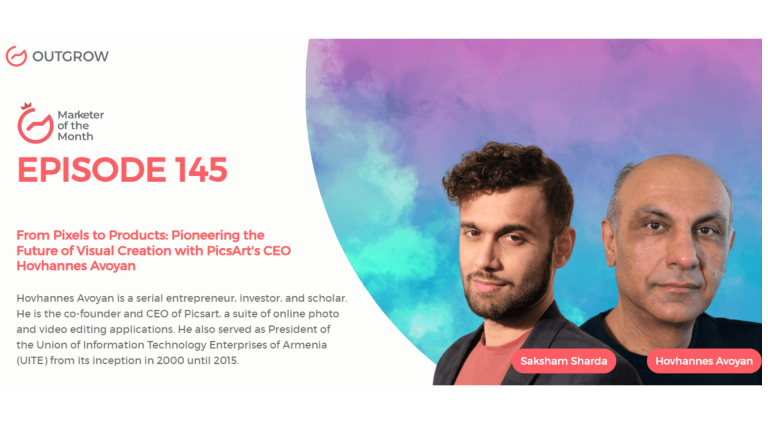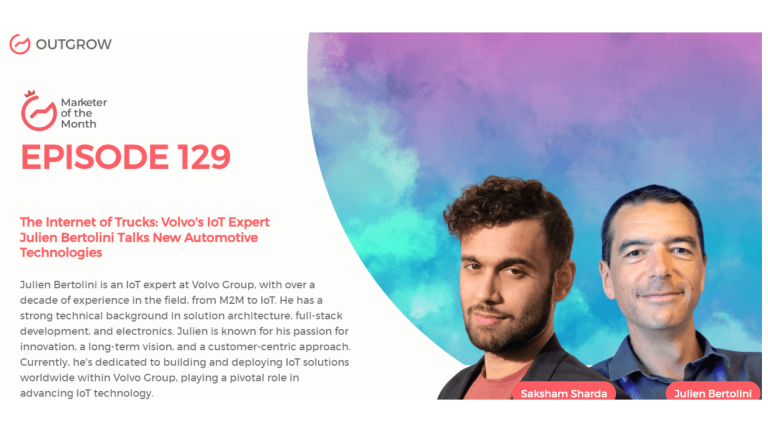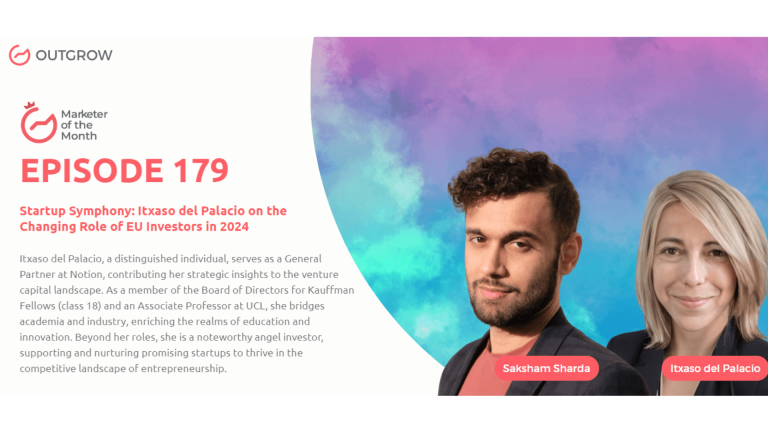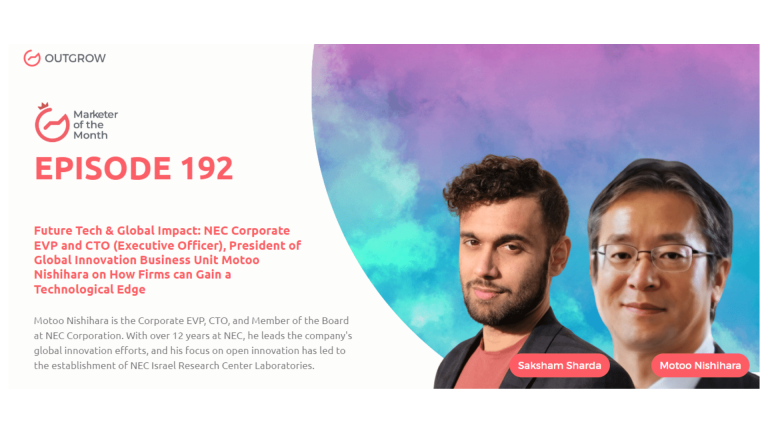EPISODE 135: Marketer of the Month Podcast with Kai Hackbarth
Table of Contents
Hey there! Welcome to the Marketer Of The Month blog!
We recently interviewed Kai Hackbarth for our monthly podcast – ‘Marketer of the Month’! We had some amazing insightful conversations with Kai and here’s what we discussed about-
1. Evolution of the IoT landscape.
2. IoT middleware for embedded devices.
3. Growing importance of cloud and edge computing.
4. Collaboration and open environments in IoT.
5. The significance of real-time analytics.
6. Challenges in SaaS and PaaS integration.
7. Enhancing elderly quality of life with IoT.
About our host:
Dr. Saksham Sharda is the Chief Information Officer at Outgrow.co. He specializes in data collection, analysis, filtering, and transfer by means of widgets and applets. Interactive, cultural, and trending widgets designed by him have been featured on TrendHunter, Alibaba, ProductHunt, New York Marketing Association, FactoryBerlin, Digimarcon Silicon Valley, and at The European Affiliate Summit.
About our guest:
Kai Hackbarth, currently the Senior Technology Evangelist at Bosch Global Software Technologies, brings over 21 years of experience in IoT middleware and device management across various sectors, including Smart Home, Industrial IoT, and Automotive. He has also held leadership roles at OSGi Alliance and the Industrial Internet Consortium. In recognition of his influence and expertise, Kai was named among the “Top 100 IIoT Influencers” by Onalytica in 2020.
In the Blink of Data: Real-Time IoT Wisdom with Bosch’s Senior Tech Evangelist Kai Hackbarth
The Intro!
Saksham Sharda: Hi, everyone. Welcome to another episode of Outgrow’s Marketer of the Month. I’m your host, Dr. Saksham Sharda, and I’m the creative director at Outgrow. co. And for this month we are going to interview Kai Hackbarth who is the Senior Technology Evangelist at Bosch Global Software Technologies.
Kai Hackbarth: Great to be here. Thank you.
Don’t have time to read? No problem, just watch the Podcast!
Or you can just listen to it on Spotify!
The Rapid Fire Round!
Saksham Sharda: Alright, so let’s start with the rapid-fire round. The first question is, at what age do you want to retire?
Kai Hackbarth: I don’t know yet. I guess as early as possible.
Saksham Sharda: How long does it take you to get ready in the mornings?
Kai Hackbarth: 20 minutes.
Saksham Sharda: Most embarrassing moment of your life?
Kai Hackbarth: I don’t know, I have to admit right now.
Saksham Sharda: Favorite color?
Kai Hackbarth: Blue.
Saksham Sharda: What time of day are you most inspired?
Kai Hackbarth: In the morning.
Saksham Sharda: How many hours of sleep can you survive?
Kai Hackbarth: I guess between six and eight.
Saksham Sharda: Fill in the blank. An upcoming technology trend is ______.
Kai Hackbarth: Okay. So I say, Meta.
Saksham Sharda: The city in which the best kiss of your life happened?
Kai Hackbarth: Athens, Greece.
Saksham Sharda: Pick one, Mark Zuckerberg or Elon Musk.
Kai Hackbarth: Okay, that’s a good question. I guess Mark Zuckerberg.
Saksham Sharda: How do you relax?
Kai Hackbarth: How am I relaxing? Fishing.
Saksham Sharda: How many cups of coffee do you drink per day?
Kai Hackbarth: Too many.
Saksham Sharda: A habit of yours that you don’t like?
Kai Hackbarth: A habit of mine that I don’t like, always saying Yes.
Saksham Sharda: The most valuable skill you’ve learned in life?
Kai Hackbarth: Being communicative and flexible.
Saksham Sharda: Your favorite Netflix show?
Kai Hackbarth: What was it called with, I don’t remember the name right now. No, I don’t remember.
Saksham Sharda: One-word description of your leadership style.
Kai Hackbarth: Moderating, I would call it.
Saksham Sharda: Memorable career milestone.
Kai Hackbarth: Yeah. I just had this while taking over a product from another business unit in Bosch.
The Big Questions!
Saksham Sharda: Alright, that’s the end of the rapid-fire round. I’ll go onto the normal questions that you can answer with as much ease of time as you like. The first one is, you have 20 years of experience in designing and developing innovative solutions across IoT. How has the IoT landscape evolved during your career and what trends do you find most exciting today?
Kai Hackbarth: So, I mean, when I started in 2001, right? It was a company called ProSyst Software and we were focusing already on IoT middleware for embedded devices. Back in the day, we didn’t use the term IoT, right? So that was you know, coming in 2005-2006. But in principle, we already did, you know, what we do today to connect devices via gateways. And I think what has changed is, you know, that a lot of new technologies have come into play now, most recently Meta, which I think is a great development, right? What we have seen over the years, is the importance of the cloud for storing, analyzing data, managing devices, and then also coming back to the edge devices. You know, we have as much as possible business logic on the device near the asset if you want, right? I wouldn’t say an even advancement, but it’s like, you know, we are coming back to what we, you know, started if you want to some extent, right? In 2001, I remember very well mean, we had a solution, in my opinion, for a problem that did not exist. Yeah. So because nobody wanted to connect you know, their assets. We’re talking to CAR OEMs, for example, right? And like offering an open IOT middleware for cars was like, you know, a total no-go to them was like evil if you want, right? Yeah. So I think today what excites me about IoT is you know, how open the environment has become, if you want. Also, companies collaborating on technology enable this, right? I think where we need to still get better is like, you know, getting the business models to fly for everybody, right?
Saksham Sharda: And are there any other problems that don’t exist yet for which you think you already have solutions?
Kai Hackbarth: Yeah, I don’t know if any problems do not exist, but we have a solution. But, in principle, you know, what we are good at is like, you know doing software updates on embedded devices. Yeah managing these devices remotely and connecting devices. This, I would call it, is, you know, at least my daily business if you want. Right? And this is always changing, obviously, right? So new technologies come in, right? You need to do this on different cloud environments and so on. So I think, you know, what you have to do is stay flexible also in technical terms.
Saksham Sharda: Can you share some insights into your work in smart home technology and energy management?
Kai Hackbarth: I mean when I started at that back then, right? So, which Bosch acquired in 2015, I would say Smart Home was our biggest market, right? So back then, you know, we were talking about technologies like Z Wave, ZigBee, and so on to connect devices in the homes. Today, I think the most exciting development to me is like, you know, Meta which is an evolution of ZigBee and Thread, right? Other big players participate, you know, namely Google, Apple, Amazon, and so on, right, which in my opinion, really helps us to build a truly interoperable ecosystem. We still have to see how it will play out. We are still in the early stages but I believe this is like, you know, a very big step forward. And in terms of energy management in Germany, we have a technology that is called eBus which is basically, you know enabling devices at home, be it, you know, energy consumers or energy producers to communicate with each other. This enables various use cases for e-mobility, for white good appliances, and so on, right? Many other types of devices, also HVAC and I think this is also very crucial. Yeah. And so we do have you know a lot of customers that use our Bosch IoT Edge services, which is implementing this eBus technology to avoid all these issues that are, you know, coming with a large rollout of electric vehicles and so on. Right.
Saksham Sharda: So in your view, how do consumer preferences and demand influence the direction of innovation in the smart home technology sector?
Kai Hackbarth: Yeah, I mean you see this really in the sense like, you know, which devices are like on mass market devices, really, right? So, I mean, you know with Alexa or the Echo devices with the Apple and Google, you know, devices. Yeah. Right? And I think, you know, with this, you collect a lot of inputs. What users want to do at home, right? And I believe you know, it’s sort of a sad thing in the end, but, you know, the war in Ukraine also forced us to think about how we can reduce energy at home, right? How can we, you know, optimize heating and all this, right? And I believe there’s still a lot of innovation, you know, coming from basically bringing all the different assets that you have in a home yet together, and, and to analyze this. And to learn, and then also implement new features on top of it, right? So, which in turn, really brings new optimizations, right?
Saksham Sharda: So let’s talk about something else. You’re a founding member of several open-source initiatives. What drives your passion for open-source projects?
Kai Hackbarth: So, I mean generally I have always been basically since the beginning, you know, as I joined Bosch software, a big believer in open standards, right? So because this is, you know, what brings, you know, the community together, which you know, allows you to build ecosystems, right? And so open standards are one way open source is the other way, right? And so Bosch has been for many years already a big promoter of, for example, the Eclipse Foundation, right? So we have several open-source projects that are the foundation of our IoT platform, right? And so we do this for several reasons. One is also for purely internal reasons, because working within, you know, Bosch between different business units, you always have, you know, the struggle of who owns which IP, for example, right? So with this, we solve this problem, if you want, right? AndBosch also recognized from early on, yeah we cannot do this alone, right? So, we need ecosystems and we need a community, let’s say, around our platforms if you want. And in our opinion, open source is the way to go.
Saksham Sharda: So, in your experience, what role does telematics play in vehicle-to-vehicle and vehicle-to-infrastructure communication? How is this technology shaping the future of transportation and safety?
Kai Hackbarth: I mean, I think this is, you know, a very changing environment right now, right? So if you look at what is happening in cars I mean, also what the OEMs now do, right? So they came up with their new operating systems, in-car operating systems, various software-defined vehicle initiatives, and so on. The fact that 5G is now, you know yeah. Come or there if you want, right? So I mean, all this, in the end, will play towards the car-to-car, car-to-infrastructure communication, enabling new services for safety, right? But also you know yeah, I mean, like what you call it location-based services if you want, right? And we are, for example, working on connected tires right now, which we believe is also, you know, a big thing, which is highly underestimated, right? Because a tire is a tire, right? But if you connect it, yeah, you can add value to it, not just for safety, but also for fuel or energy consumption in the end, right? I think, you know, we still have to see how this ecosystem will play out, right? But I mean, cars will be connected, electric cars will be, you know, software-defined, right? So yeah, we’ll have to see.
Saksham Sharda: So tiles collecting data seems like a new concept. Could you talk more about the technology and sensors involved in this data collection process?
Kai Hackbarth: Sure. So, I mean the way this works today, right? So we focus as of now on, for example, trucks, agriculture, vehicles, this sort of vehicles where you have an immediate benefit. Where you have companies with fleets. Yeah. So we put a sensor in the tyre. It doesn’t have to come from Bosch. Also, lots of tyre manufacturers already have their sensors, right? That’s what they lack today, is the capability to combine this with data that is coming from the car. And this is where, you know, Bosch comes into play, right? So because we can provide, for example, a telematics unit, we can connect, let’s say the sensor collects the data from the car, see you know, with analytics, what’s the wear and tear of the tyre can, you know give recommendations for like how much pressure, you know, the tyre should have in order, for example, to reduce fuel consumption things like this, right? So it’s rather simple in the sensor itself you know, talks Bluetooth, low energy today could also be some other wireless technology. Then we have a receiving unit that collects the data. And then the telematics unit, you know, combines data from the vehicle with a tire sensor, and we send it, you know, if you want to the cloud to do some, you know analytics around it and give you recommendations, warnings, whatever is necessary.
Saksham Sharda: So real-time analytics is often discussed. But what are the specific challenges in implementing it, and how does it differ from analyzing historical data?
Kai Hackbarth: Yeah, I mean the thing is, it depends, I mean, it’s like a broad question here, right? But I mean depending on the use case, right? You get a lot of data, in most cases unstructured data, right? So, they could come from multiple sources, right? So there could be, you know, data from the tire, there could be weather information that you get from the cloud if you want, from a service, and so on, right? And I mean, especially in safety-critical use cases, right? So you need this real-time capability, right? So, and that means you have to do this as close to the edge Yeah. Where, you know the use case is happening, right? And yeah, so that’s, you know, what we try to do, right? Use the analytics, yeah. We get unstructured data from different sources. We, you know, sort of do our analytics at the edge, right? And then basically add value to specific use cases.
Saksham Sharda: So could you share a specific project or use case where Bosch has successfully implemented real-time analytics demonstrating its benefits in practice?
Kai Hackbarth: I mean, there are probably many use cases that I’m not even aware of, right? So the tyre you know, the use case is one example, right? So especially for safety-critical you know yeah, use cases, right? So the tyre is about to blow, for example, right? So I mean, this, you don’t want to get from the cloud, right? But there are also many use cases, especially in factories, right? So you get lots of data from multiple machines, right? You want to do predictive maintenance, for example, right? So for example, one machine, let’s just say it’s heating up for an unknown reason. Yeah. and you want to sort of, you know, analyze what is the root cause, right? And yeah, this is what you can do, you know, if done right? Yeah. what you can do with real-time analytics at the edge, right?
Saksham Sharda: So let’s talk a bit about SaaS and PaaS. SaaS and PaaS are crucial components of modern software development. How do these services contribute to the success of IoT projects and what challenges do developers face when working with them?
Kai Hackbarth: Yeah, I think this is a good question because I mean, if you look at it, what has happened in the past few months, I guess, right? So many players, yeah, basically let’s say stop the IOT business or there is some kind of consolidation ongoing, right? And I believe one of the reasons is especially when you have, you know, a SaaS or a PaaS offering, you have infrastructure cost, right? So I mean, you build it for like, you know, a large amount of customers for large amounts of data coming in and so on, right? And I think the problem that many players had is the fact that this was, you know, too expensive and they, you know, didn’t get any profit or not enough profit out of it, right? I believe it’s still crucial to have, you know, IoT platforms as a service available, right? Especially, you know, when you start with small volumes, right? But what we do see now is that you know, a lot of customers are interested in, for example, on-premise deployments to manage their cost in a better way, if you want, right? Yeah. So that’s, I guess you know, my answer to this.
Saksham Sharda: So what advice would you give to organizations seeking to navigate the complex landscape of SaaS and PaaS integration within the IoT initiatives?
Kai Hackbarth: I mean, it depends on maturity, obviously, right? So if you start from zero, I would suggest getting advice, right? So, I mean, it doesn’t need to be like an expensive let’s say consulting company, right? But companies that have experience yeah, in building, deploying this type of systems I would call it, right? And, you know, discuss the use case, discuss, you know, potential deployment models and you know, what it means in terms of costs, right? And so on, right? I mean, in the end, right? So, the business model is crucial, right? And you need to, let’s say, obviously start small, but you need to think about how you grow and how your costs develop, right? And this is, yeah, difficult exercise, obviously, right?
Saksham Sharda: Ambient assisted living is an area of growing importance, especially in an aging society. How can IoT technologies improve the quality of life for elderly individuals?
Kai Hackbarth: I think, I mean since I’ve done my first ambient assisted living projects in the early two thousand, if you want, right? So in the end, right? So there is a lot that can be done for, you know, for safety if you want for the elderly people, right? So be it, sleep, be it, you know, if they fall or so, right? But also to keep them active yeah. So that they are not bored at home and so on, right? So the problem really, it’s not, the technology, technology is already there. Many companies have offerings, right? From like, you know, connected pillows to fall sensors, you name it, right? The problem is you know, on the, I would call it the user side. And by this, I mean, you know, the acceptance of you know, using this technology, right? Because elderly people, you know, feel, let’s say monitored, right? And you know, it’s in some cases maybe even too modern for them because they feel like, you know they have to adjust their, let’s say, lifestyle if you want, right? And that’s, I think, the challenge you see in certain countries where, you know, ambient assisted living is really on the forefront, especially the UK comes to my mind, right? But in many other countries, I think, you know, it probably will work for our age. Yeah. but for the current elderly people, I think it’s still a challenge to convince them to accept this kind of technology.
Saksham Sharda: Okay, the last question for you is of a personal mind. What would you be doing in your life, if not this right now?
Kai Hackbarth: What would I be doing? That’s a good question. I guess I’m, I mean, I’m living in Greece, you know, I would probably spend a lot of time at the beach.
Let’s Conclude!
Saksham Sharda: Thanks, everyone for joining us for this month’s episode of Outgrow’s Marketer of the Month. That was Kai Hackbarth who is the Senior Technology Evangelist at Bosch Global Software Technologies.
Kai Hackbarth: Pleasure. Thanks for having me.
Saksham Sharda: Check out the website for more details and we’ll see you once again next month with another marketer of the month.
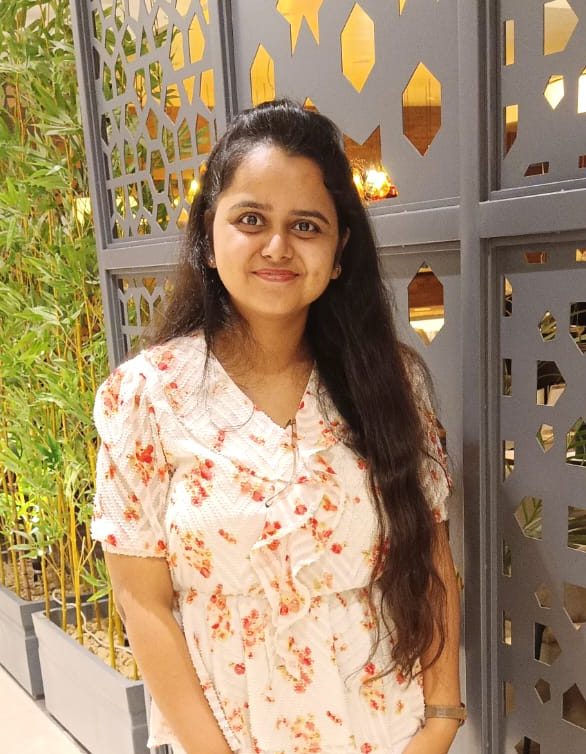
Muskan is a Marketing Analyst at Outgrow. She is working on multiple areas of marketing. On her days off though, she loves exploring new cafes, drinking coffee, and catching up with friends.





